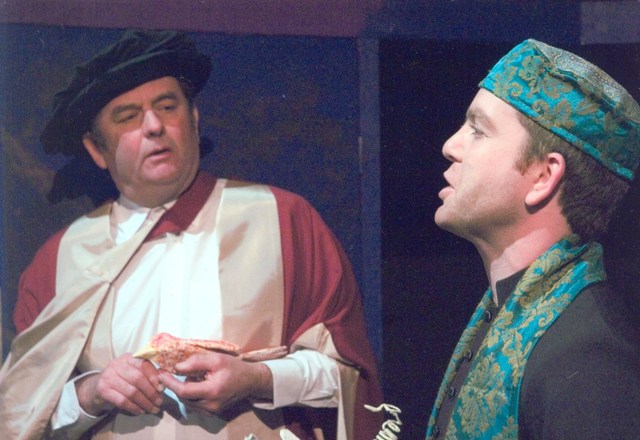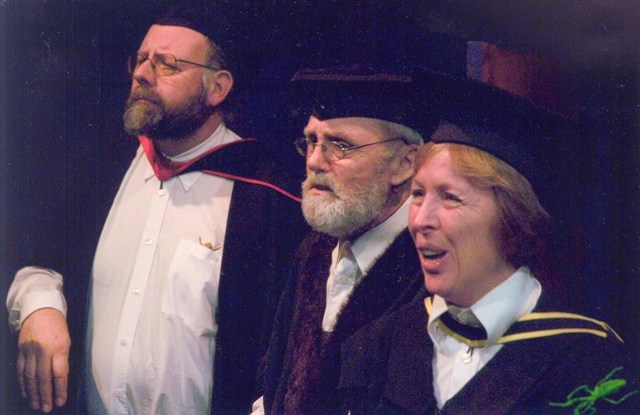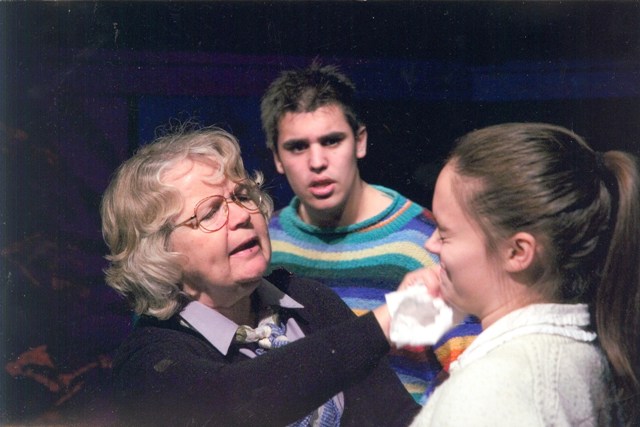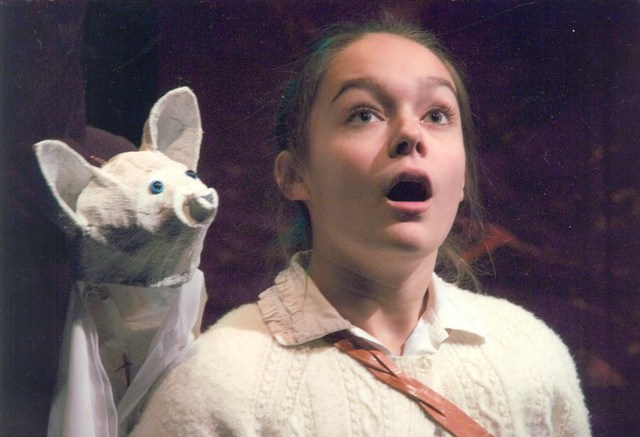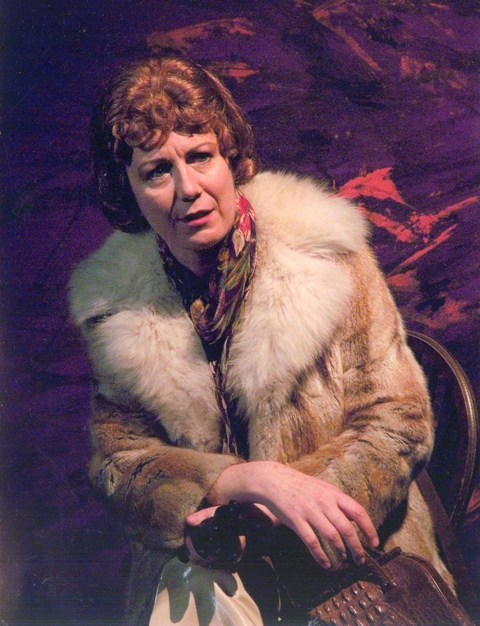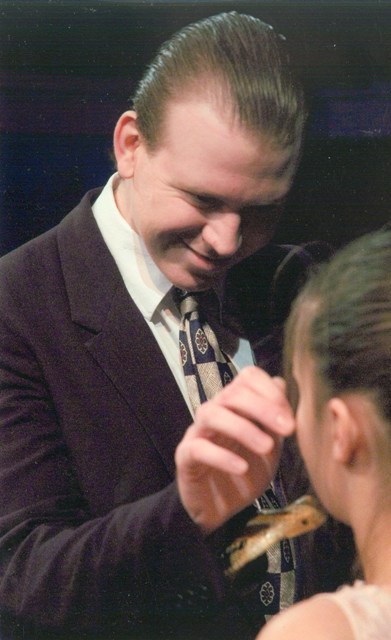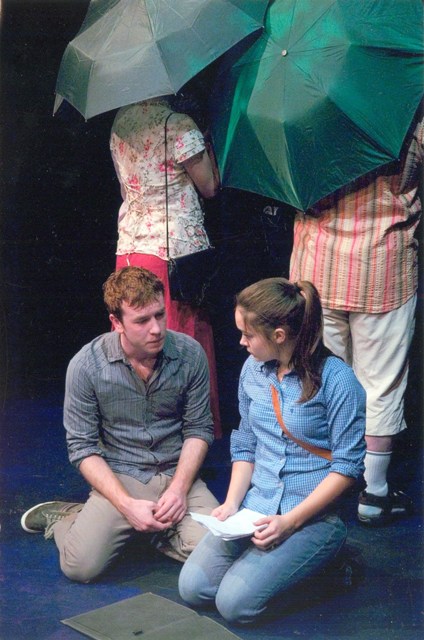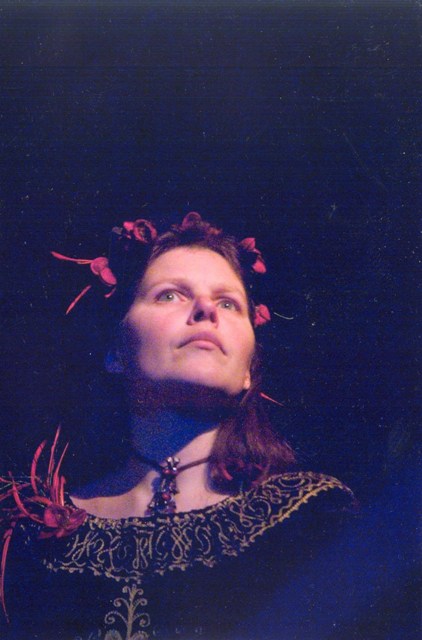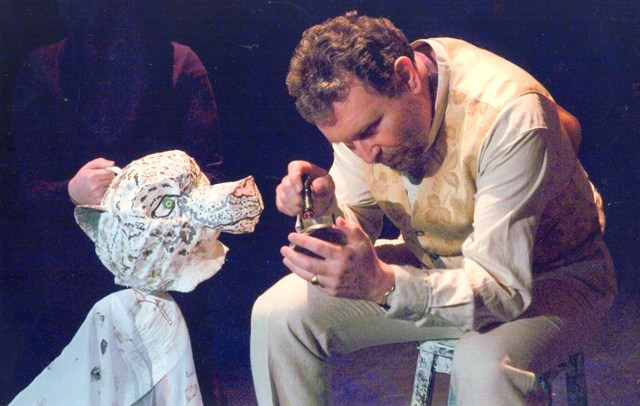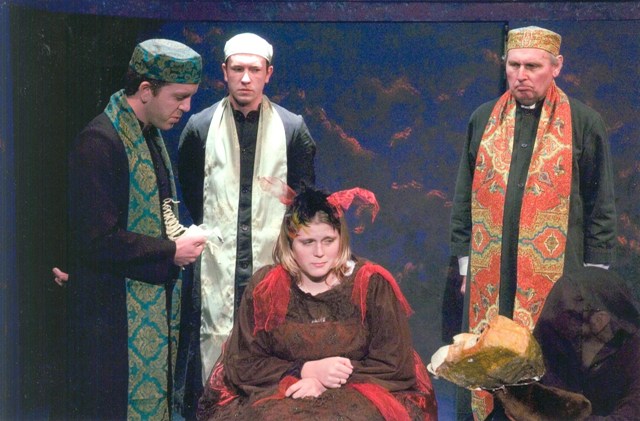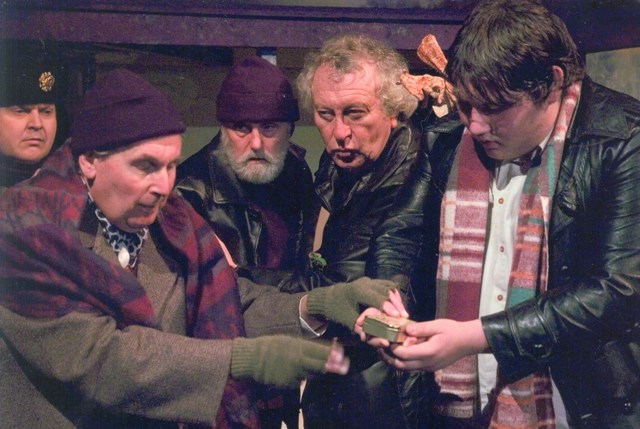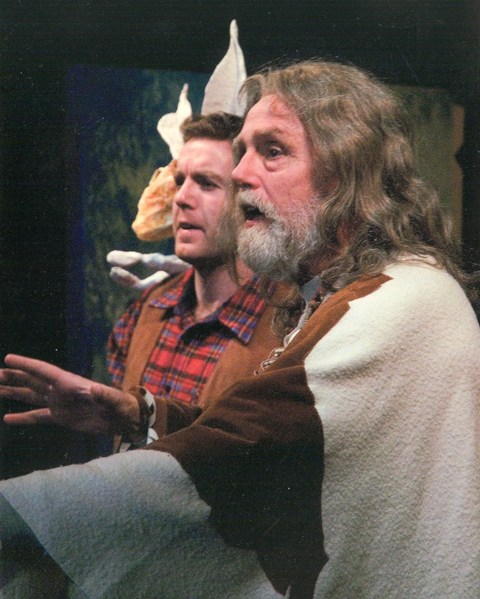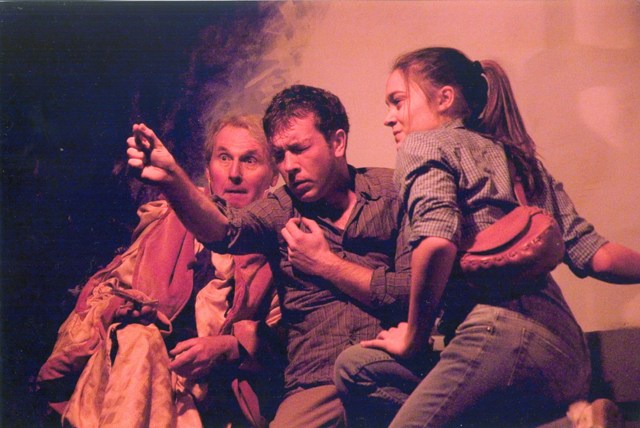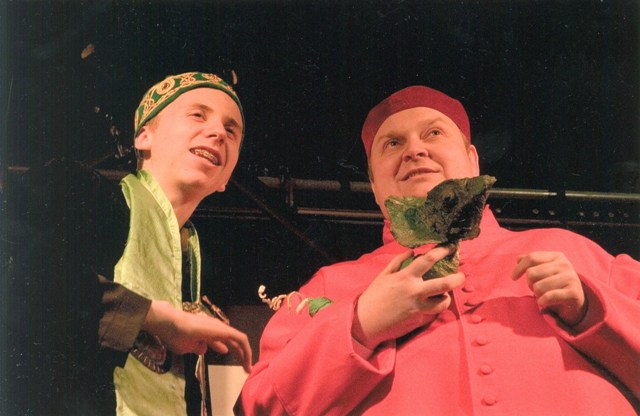The Bench Production
This production was staged over two performances at Havant Arts Centre, East Street Havant - Bench Theatre's home since 1977.
Cast, Play One
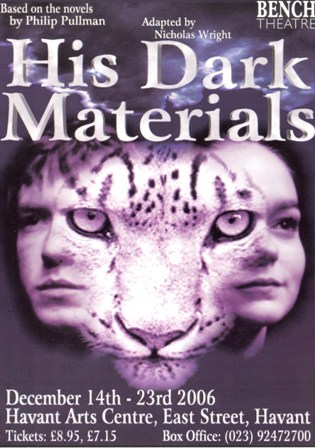
BETWEEN THE WORLDS
| Lyra Belacqua | Charley Callaway |
| Pantalaimon, her daemon | Sean Buchan |
| Will Parry | Martin McBride |
OXFORD
| Mrs Coulter | Sally Hartley |
| Golden Monkey, her daemon | Darryl Wakelin |
| Lord Asriel | David Penrose |
| Stelmaria, his daemon | Vicky Hayter |
| Master of Jordan College | Alan Welton |
| Scholars of Jordan College | members of the company |
| Mrs Lonsdale, housekeeper | Ingrid Corrigan |
| Thorold, Asriel's manservant | Jeff Bone |
| Cawson, the Steward of Jordan College | Megan Green |
| Fra Pavel, of the Consistorial Court | Neil McBride |
| Roger Parslow, a kitchen boy | Peter Di Fonzo |
| Salcillia, his daemon | Alice Corrigan |
| Tony Costa | Liam Fleming |
| Billy Costa | Ben Mitchell |
| Oxford/Gyptian children | members of the company |
LONDON
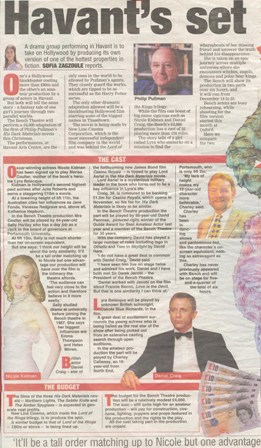
| Lord Boreal | Nathan Chapman |
| Stall-holder | Sharman Callam |
| Top Hatted Man | Mark Wakeman |
| Ship's Captain | Julie Wood |
| Servant | Zoë Chapman |
| Tartar Guards Abducted Children | members of the company |
TROLLESUND
| Lord Faa, Lord of Western Gyptians | Peter Corrigan |
| Farder Coram | John Scadding |
| Iorek Byrnison, an Armoured Bear | Marcus Bennison |
| Lee Scoresby, a balloonist | Neil McBride |
| Hester, his daemon | Zoë Chapman |
| Kaisa, Serafina's daemon | David Penrose |
| Citizens of Trollesund | members of the company |
BOLVANGAR
| Doctors Nurses Abducted Children | members of the company |
| Tortured Witch | Sarah Fencott |
SVALBARD
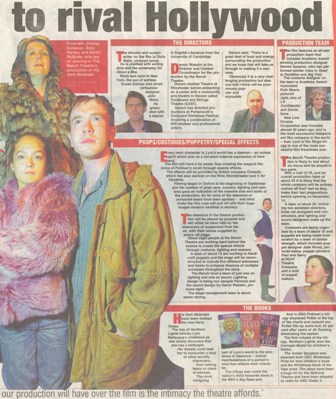
| Iofur Raknison, King of Armoured Bears | Peter Corrigan |
| Armoured Bears | members of the company |
GENEVA
| President of the Consistorial Court | Mark Wakeman |
| Brother Jasper | William Perrins |
LAPLAND
| Serafina Pekkala, Queen of Lapland Witches | Julie Wood |
| Ruta Skadi, Queen of Latvian Witches | Megan Green |
| Pipistrelle | Emma Searle |
| Caitlin | Emily Tipper |
| Grimhild | Lorraine Galliers |
| Grendella | Charlotte Self |
| Witches | members of the company |
| Jopari, a shaman | Peter Woodward |
CITTÀGAZZE
| Angelica | Jo Wakelin |
| Paolo | Ben Mitchell |
| Giacomo Paradisi | John Scadding |
| Tullio | Alistair Cree |
OXFORD
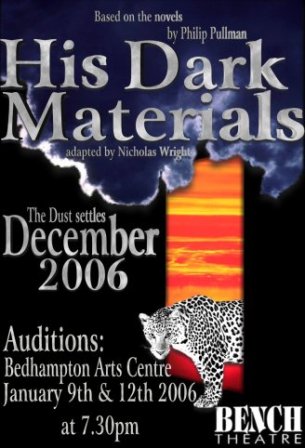
| Librarian | Emily Tipper |
| Assistant Librarian | Alice Corrigan |
Cast, Play Two
BETWEEN THE WORLDS
| Lyra Belacqua | Charley Callaway |
| Pantalaimon, her daemon | Sean Buchan |
| Will Parry | Martin McBride |
GENEVA
| President of the Consistorial Court | Mark Wakeman |
| Brother Jasper | William Perrins |
| Fra Pavel, of the Consistorial Court | Neil McBride |
| Church Council | members of the company |
OXFORD
| Lord Boreal | Nathan Chapman |
| Mrs Coulter | Sally Hartley |
| Golden Monkey, her daemon | Darryl Wakelin |
| Lee Scoresby, a balloonist | Neil McBride |
| Hester, his daemon | Zoë Chapman |
CITTÀGAZZE
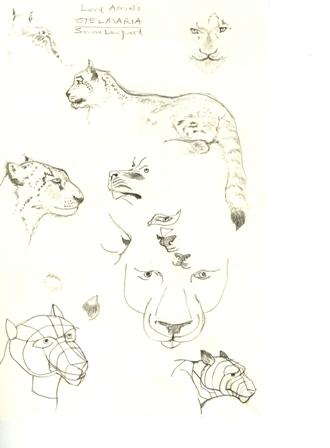
| Serafina Pekkala, Queen of Lapland Witches | Julie Wood |
| Pipistrelle | Emma Searle |
| Caitlin | Emily Tipper |
| Grimhild | Lorraine Galliers |
| Grendella | Charlotte Self |
| Witches | members of the company |
| Giacomo Paradisi | John Scadding |
| Angelica | Jo Wakelin |
| Paolo | Ben Mitchell |
LORD ASRIEL'S FORTRESS
| Lord Asriel | David Penrose |
| Stelmaria, his daemon | Vicky Hayter |
| Lord Asriel's Forces | members of the company |
| Church Forces | members of the company |
| Thorold, Asriel's manservant | Jeff Bone |
| Lord Roke, a Gallivespian | Sharman Callam |
| Chevalier Tialys, a Gallivespian | Robyn Hunt |
| Lady Salmakia, a Gallivespian | Francine Huin-Wah |
CITTÀGAZZE MOUNTAINS
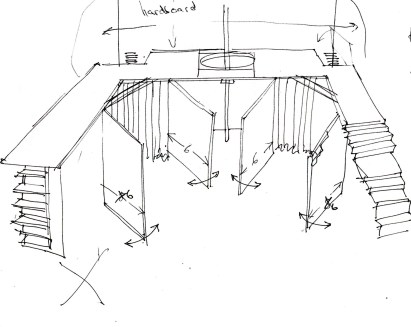
| Ruta Skadi, Queen of Latvian Witches | Megan Green |
| Jopari, a shaman | Pete Woodward |
| Balthamos, an angel | Emma Searle |
| Baruch, an angel | Alan Welton |
NORTHERN MOUNTAINS
| Iorek Byrnison, an Armoured Bear | Marcus Bennison |
| Armoured Bears | members of the company |
LAND OF THE DEAD
| Perkins, an official | Neil McBride |
| Boatman | Nathan Chapman |
| The Jones | members of the company |
| Their Deaths | members of the company |
| The Dead | members of the company |
| No-Name, a harpy | Zoë Chapman |
| Harpies | Jo Wakelin & Emily Tipper |
| Roger Parslow, Lyra's friend | Peter Di Fonzo |
UNKNOWN WORLD
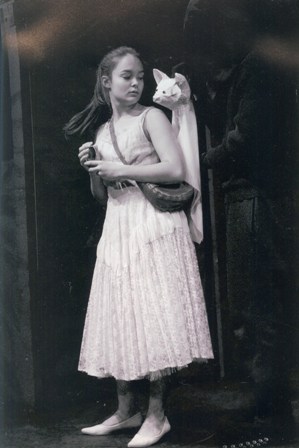
| Kirjava, Will's daemon | Charlotte Self |
Crew
| Producer | Jaspar Utley |
| Production Secretary | Robin Hall |
| Stage Manager | John Wilcox |
| Assistant Stage Managers | Sian Green Andy Lai |
| Lighting Operation | Emma Bailey |
| Sound Operation | Derek Callam Chris Stoneham |
| Production Workshops | Damon Wakelin Martin McBride Sue Dawes Charley Callaway Marion Simmons Ellie Dawes Daisy Dawes Hat Grunstein Frankie Washtell |
| Publicity | Jaspar Utley Sue Dawes |
| Front of House | Gina Farmer |
Creative Team
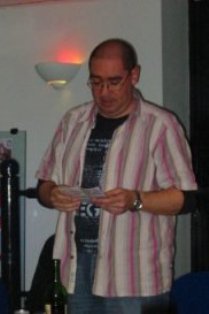
| Director | Damon Wakelin |
| Assistant Directors | Nathan Chapman Jacquie Penrose |
| Costumes | Sue Dawes Bridget Tipper Lucy Tipper Sophie Meechan Marion Simmons Hat Grunstein Sarah Pook Teresa Owen Ellie Dawes Daisy Dawes |
| Set Design | Damon Wakelin Pete Woodward Kevin West John Wilcox |
| Set Model | Pete Woodward |
| Set Construction | John Wilcox Kevin West Pete Woodward Simon Growcott |
| Puppet Design Concept | Julie Wood |
| Puppets | Julie Wood Darryl Wakelin David Penrose Emma Skinner Neil McBride Martin McBride Sue Dawes Vicky Hayter Frankie Huin-Wah Zoë Chapman Alice Corrigan Jo Wakelin Ingrid Corrigan Gemma Knight |
| Puppetry Consultants | SCAT Theatre Company |
| Bear Masks | Caron O'Rourke Alice Corrigan |
| Lighting Design | Jacquie Penrose |
| Sound Design | Darryl Wakelin |
| Poster Design | Nathan Chapman |
| Fight Director | Damon Wakelin |
| Programme Design | Derek Callam |
Director's Notes
This has been a production long in the making. In purely practical terms the show has had a full 15-month life cycle. The company bravely, (perhaps, foolishly?), selected His Dark Materials, (HDM), back in October 2005; auditions were held in January 2006 and we have been rehearsing on and off since late February 2006. It is now December. But the full story starts even earlier.
In December 2004 The Bench staged "A Christmas Carol", directed by Mark Wakeman, as the launch pad for Havant Arts Centre's ongoing plan to have a major production during the Festive period. HumDrum AmDram then stepped into the breach last year with their excellent "James and the Giant Peach", which saw the ball back in the Bench's court.
I wasn't consciously looking to pick up the baton, but I was already interested in HDM as a potential project, probably for the Youth Theatres that I run at Havant Arts Centre. I knew, and loved, the books, but it was seeing the National Theatre's revival of HDM that really started me thinking.
The National production was a really impressive beast; a cast of thousands and a £1 million budget. And it showed. Every conceivable stage trick was employed; 2 revolving stages; the infamous National drum revolve, video projections and live action video relays. The level of spectacle was immense. However, I came away from it feeling that the intimate heart of the story had been rather swamped by all the trickery - a seed was planted.
I often reflect on seeing shows as to how the Bench might fare if they were to stage it and this was one example where I felt we might be able to do something that the National couldn't. Brave words, I know, but bear with me. Our main advantage, I thought, was that whilst we could in no way rival the sheer scale of the National production, the intimate nature of our venue lent itself to connecting more tellingly with the emotional heart of the story.
So, I got hold of a copy of the script and set about testing its viability within the Bench context. It was clearly an enormous undertaking but I felt we could do it; the precedents were all there. When we do them, we are good at large cast plays; we have done a double-bill previously, "Martin Chuzzlewit"; we had the feel good factor of Mark's "A Christmas Carol" and I have previously directed several large cast plays with the Bench, most recently "Haroun & the Sea of Stories". And so to Play Selection. I can't recall ever hearing a collective gasp as a director announced the title of the play they are proposing. Such was the reaction I received - in a good way. And here we are.
From my original machinations a number of key elements have remained intact. 'Borrowing' from the National, we are using puppets and masks for many of the key characters; the set operates on different levels and has an increased entrance/exit capacity and the cast is 30+ with most people playing a multitude of different roles. We are also trying to keep the action constantly flowing between scenes - there are only four blackouts in the whole six hours, one for the end of each Act. (So if the lights do go out, it is time to clap!)
As the play is unlike anything we have ever done before, I decided to try something different at Auditions. Rather than working from the text of the play, we workshopped around a number of key elements of the production. Nathan Chapman led a movement section focusing on Bears and Angels; Jacquie Penrose led a section on multi-role characterisations and Paul and Gerry from SCAT Theatre Company headed up some introductory work on working with puppets. For an impartial view, here is a snippet from Nathan's blog entry on the Bench website.
"The auditions were really interesting. The emphasis was very much on work-shopping people and ideas, and a great deal of the work was done collectively. This was great as it meant people (particularly those new to the company) didn't feel put on the spot, allowing them to try out all the ideas. Even at this early stage, there is a strong sense of ensemble and a very supportive attitude to the project, with people integrating quickly, sharing experiences, discussing ideas etc. I managed to look in on some of the puppet work at the end of the evening, and even had a go myself. Paul and Gerry are brilliant not only at bringing the puppets to life, but also at coaching the rest of us. I think some truly excellent work is going to emerge from this area of the performance, as already people were able to animate puppets of different sizes, imbuing them with characters, responses and emotions."
Which brings us to the rehearsal period. The single most heartening aspect of rehearsals was the fantastic atmosphere that existed whenever the cast was gathered together. Given that we have a huge cast covering an enormous spectrum of both age and experience, the team spirit seems to be very strong throughout. It was never going to be easy to juggle the needs of 37 actors against the needs of any single rehearsal, but the combination of patience, energy and sheer willingness to work hard and to support each other has been positively enervating.
The show combines the epic with the intimate and this provided me, as director, a highly enjoyable challenge. It has been just as rewarding to work on the, crucial, relationship between Lyra and Will as it has to painstakingly choreograph large scale set pieces such as the duel at Svalbard, (18 actors galumphing about as Armoured Bears!), and the escape from Bolvangar - an enormous, high impact sequence that involves every single member of the cast.
A production of this scale often sees the 'crowd' scenes being overlooked and I was conscious that I didn't want the hard work everywhere else to be undermined by my glossing over these moments. Each crowd throws up its own challenges, but the essence of successful crowd activity is to apply central character rules to each and every minor character. That is to say that every moment, every action, every thought and deed is considered, motivated, real and believable. Gyptians have created a regional identity for themselves; Bears were afforded separate characterisation sessions in an effort to create distinct individuals within an otherwise amorphous 'mass' of Bears, (so watch out for Stupid Bear, Ambitious Bear, Excited Bear and Cowardly Bear!); Oxford Pedestrians were encouraged to create their own private identities within a potentially theatrically deadly background moment. From the Bench blog, Peter Corrigan;
"We spent our Sunday morning in the Arts Centre setting up the scenes with the Gyptians embarking on their expedition to rescue the stolen children. Damon is the only one with a clear picture in his mind's eye of the visuals, helped by Pete Woodward as the set designer. It is really interesting therefore to know that you are acting a scene under the central upstage raised area with a climbing pole linking. We tried a number of regional accents for the Gyptians with varying degrees of success. The Anglian proved too difficult to maintain, Mummerset sounded too comical and the Pompey not distinct enough. Therefore we settled upon my native flat Yorkshire, which throws a challenge to the citizens and especially the Mayor of Trollesund as to which accent they can adopt. The main scene this morning took a while to set up but it was to the credit of the director and the script that the moment when the Alethiometer is produced became quite magical."
Away from the rehearsal room, there has been a hive of almost constant activity, too. Peter Woodward skilfully adapted my terrible sketches to create a fantastic 3-D realisation of the set that was further developed as Kevin West and John Wilcox came on board. I know that Kevin's previous experience with the large-scale productions regularly staged by Dynamo Youth Theatre has proved invaluable. Julie Wood came up with the design concept for the puppets and, along with a dogged team of makers, has been absolutely crucial to helping create an integral element of the show. Jacquie Penrose on lights, her working brief to make a silk purse from a sow's ear and Darryl, my little brother, not only bringing extraordinary life to a Monkey, but for designing all the sound effects. He somehow found time to get married along the way. As for Sue Dawes and her amazing, ever expanding team of costumiers... wonderful. And I should like to publicly acknowledge the central role played by Jasper Utley, Lead Producer, who has been utterly tireless in keeping everyone energised as well as chasing down sponsorship, press coverage and publicity outlets. He makes a mean cup of coffee, too.
The most important thing to consider when evaluating these plays is that they are plays. Not books. Nor are they films. A play cannot hope to emulate the sheer breadth of context, back story or description a novel has access to. Nor can it indulge in the sweeping, electronic trickery of the moving image. A play is an intimate and constantly evolving relationship between performers and audience. It is immediate and real. Watching a play is an active thing; all the senses are engaged. The one thing all three media have in common is that they are telling a story.
In simple narrative terms, we have two central characters whose lives and stories intertwine. Both Lyra and Will undergo a spiritual, emotional, theological and physical coming of age as unwilling central characters in a classically framed struggle between the forces of good and evil. These journeys are explored with great subtlety, warmth and wisdom whilst at the same time allowing room for the larger themes of the play to find expression. On a visceral level, the play explores notions of friendship, family, loyalty, love and inspiration, of ambition, power, greed and identity. On a cerebral plane, the plays are a constantly evolving thesis on the nature of humanity and the meaning of faith. Indeed, the books and the plays confront the sticky religious issue head-on. Pullman has been criticised for his treatment of 'The Church' in HDM. What is inescapable is that 'The Church' are the bad guys of the piece; dogmatic, zealous, ruthless, murderers, torturers and utterly unforgiving. However, this is fiction and the organisation that is Pullman's 'The Church' is in itself allegorical of any blinkered, unwavering adherence to a dogma or credo that is completely closed to any concept of 'otherness'. This can easily be applied to any form of extremism; religion, politics, nationalism, single-issue factions of any description. These are issues that resonate in our troubled times.
Finally, there is a Rose Window at Reims Cathedral with the following inscription.
"The rose window on the north side of the transept is the most beautiful of the cathedral's ancient windows. It has two themes, creation and original sin. Right at the top the suckling virgin symbolises the salvation of a sinful world by a second Eve."
This is, in essence, the theory that Pullman investigates through his 21st Century Adam and Eve. It is to the credit of both Pullman and Nicholas Wright, that their collective discourse is neither dogmatic nor unyielding but is, in fact, full of warmth and a loving, embracing celebration of humanity, warts and all.
Enjoy the shows; I'm off for a lie down.
Damon Wakelin
Sound Designer's Notes
The sound and music for this production has presented Damon and I with a number of problems as well as opportunities for experimentation.
The main problem has been finding a way of augmenting the story without interfering with the action on stage or distracting the audience in any way (who really need to concentrate without being overwhelmed by inappropriate sound activity). An additional issue has been how quickly the story moves - there's relatively little time in any given scene to allow for a protracted musical interlude. However, this has given us the opportunity to experiment with the possibilities afforded by such limitations: how do we use sound to help propel the drama with fitting emotional thrust?
One thing has been clear from the start: sound is perhaps more important in this production than any other Bench endeavour to date. Obviously we were never going to simply paste dramatic/weepy/scary music onto a scene (we call this 'Mickey-Mousing'), but the music and sound has to add another dimension to the emotion of the scene, or give its own clues about where things are headed. Part of the solution has been to try and avoid 'signature tunes', obvious 'filmic' styles and anything bombastic. This may suggest that we have trod a muddy middle ground, but this, I hope, is not the case. The story itself calls for a huge variation in the sound design which, I think, has helped us avoid this pitfall.
One of the features of the sound in this play will be the amount of live mixing, which the talented Derek Callam and Chris Stoneham will be doing for us. The sound controls we have in place for this production go way beyond the usual cross-fade and will include a number of electronic processing devices to help augment the action. Listen out for rapidly expanding stereo spectrums, live effects on some of the voices and some split-second incidental effects (good luck Lads!).
Some of the music in this play has already been remixed or processed by me, and in some places a small 'sample' of a piece has been looped, processed and generally changed a bit to suit our needs. Finally, for those among you who wish to test your knowledge of music, SOME of the artists/composers/groups you will hear include: Erkki Sven-Tuur, Arvo Part, Peter Sculthorpe, Kevin Volans, Philip Glass, John Cage, Zbigniew Preisner, Arnold Schoenberg, Erik Satie, Sigur Ros, Tortoise, Chicago Underground Trio, Susumu Yokota, Minotaur Shock, David Sylvian, EST, Kaada, Fourtet, Longstone and the BBC Sound effects library (well, you can't record everything yourself!).
Darryl Wakelin
Publicity Designer's Notes
The poster image is a central aspect of any production. For a large number of people, it will be their first contact with the production, so it needs to be exciting and attractive enough to draw them in and make them want to see the show.
For me, designing a poster is an essential part of the creative process, and is usually one of the first things I do when directing a play myself. But to design a poster for someone else's production is a very different responsibility, made no less daunting by the scale of these particular plays.
The first problem with His Dark Materials was the vast scope of the material. Exactly where does one start when you have such diverse concepts to encapsulate? Windows to other worlds, armoured polar bears, shape-shifting animal daemons, flying witches, God (or the Authority) and angels, the church, parallel worlds and half a dozen key characters. It was very quickly apparent that to attempt a design which included even half of these things would likely end up as a complete mess, and ideally we wanted a single striking image that would catch the eye from across the street.
I had already played around with some ideas for a poster advertising our auditions. The plays' title had already led me to some basic decisions. When something is called His Dark Materials, you are going to be using a predominantly dark palette of colours. I was taken with the bruised clouds, suggesting a sense of foreboding and gathering strife. But I knew that our real poster had to be stronger than this composition.
In the stage adaptations, the focus of the action is very firmly on Lyra and Will, so an early decision was to include the actors playing these roles in the design. I also felt strongly that the image had to have a photographic quality, which the initial mock-up lacked. So the next step after casting was to get some photos of Martin and Charley. I took dozens, not really knowing at this stage what I wanted to do with them, but not being a great photographer there were only a few of usable quality.
Nathan Chapman
Reviews
The NewsJames George
A quantum physicist's dream in the fight of good over evil
Bench Theatre's offering for the festive season, spread over two evenings is a mighty but cumbersome beast. It's a rip-roaring good-versus-evil tale set in a series of worlds, parallel to our own, and is, in many ways, a quantum physicist's dream. Director Damon Wakelin doesn't balk at the challenge with a cast of 37 and an enormous set - multi-levelled, multi-faceted and multi-doored - not to mention the splendid puppets.
Acting abilities vary. Add to that a not-too-perfect adaptation (much stuff considered vital by purists is gone altogether) an what are we left with? Actually, a worthy piece of work. The beginning of Part One suffers from information overkill - facts and names thrown out like javelins - but get past this and things quickly improve.
The usual Bench stalwarts acquit themselves more than admirably, but the big surprises come in the form of two youngsters. As Lyra, Charley Callaway is a feisty, gutsy heroine with a heart of gold. She gives an excellent, tell-it-as-it-is performance. Then there's Martin McBride as hero Will. Frankly, one rarely sees so finely-crafted a performance from an adult, let alone a youngster. In his work were truth and reality and effortlessness.
It's not festive, but put in the effort and you will be mightily rewarded.
The News, 16th December 2006
